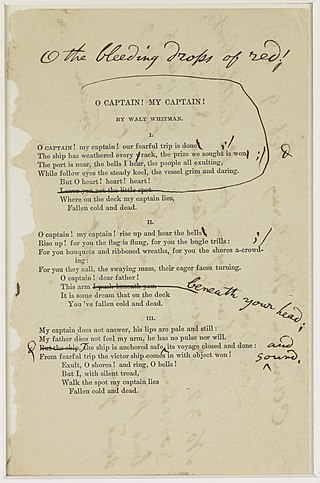Related Research Articles

Paul Klee was a Swiss-born German artist. His highly individual style was influenced by movements in art that included expressionism, cubism, and surrealism. Klee was a natural draftsman who experimented with and eventually deeply explored color theory, writing about it extensively; his lectures Writings on Form and Design Theory, published in English as the Paul Klee Notebooks, are held to be as important for modern art as Leonardo da Vinci's A Treatise on Painting was for the Renaissance. He and his colleague, Russian painter Wassily Kandinsky, both taught at the Bauhaus school of art, design and architecture in Germany. His works reflect his dry humor and his sometimes childlike perspective, his personal moods and beliefs, and his musicality.

Wallace Stevens was an American modernist poet. He was born in Reading, Pennsylvania, educated at Harvard and then New York Law School, and spent most of his life working as an executive for an insurance company in Hartford, Connecticut. He won the Pulitzer Prize for Poetry for his Collected Poems in 1955.

Harmonium is a book of poetry by American poet Wallace Stevens. His first book at the age of forty-four, it was published in 1923 by Knopf in an edition of 1500 copies. This collection comprises 85 poems, ranging in length from just a few lines to several hundred. Harmonium was reissued in 1931 with three poems omitted and fourteen new poems added.

"O Captain! My Captain!" is an extended metaphor poem written by Walt Whitman in 1865 about the death of U.S. president Abraham Lincoln. Well received upon publication, the poem was Whitman's first to be anthologized and the most popular during his lifetime. Together with "When Lilacs Last in the Dooryard Bloom'd", "Hush'd Be the Camps To-day", and "This Dust was Once the Man", it is one of four poems written by Whitman about the death of Lincoln.

Jesus walking on the water, or on the sea, is depicted as one of the miracles of Jesus recounted in the New Testament. There are accounts of this event in three Gospels—Matthew, Mark, and John—but it is not included in the Gospel of Luke. This story, following the miracle of the feeding of the five thousand, tells how Jesus sent the disciples by ship back to the "other side" of the Sea of Galilee while he remained behind, alone, to pray. Night fell and the sea arose as the ship became caught in a wind storm. After rowing against the wind for most of the night, the disciples saw Jesus walking on the water. They were frightened, thinking that they were seeing a spirit, but when Jesus told them not to be afraid, they were reassured. After Jesus entered the ship, the wind ceased, and they arrived at land.

Joan Mitchell was an American artist who worked primarily in painting and printmaking, and also used pastel and made other works on paper. She was an active participant in the New York School of artists in the 1950s. A native of Chicago, she is associated with the American abstract expressionist movement, even though she lived in France for much of her career.

Sonnet 55 is one of the 154 sonnets published in 1609 by the English playwright and poet William Shakespeare. It is included in what is referred to as the Fair Youth sequence.
"Peter Quince at the Clavier" is a poem from Wallace Stevens's first book of poetry, Harmonium. The poem was first published in 1915 in the "little magazine" Others: A Magazine of the New Verse, edited by Alfred Kreymborg.
"Le Monocle de Mon Oncle" is a poem from Wallace Stevens's first book of poetry, Harmonium. It was first published in 1918.

Justin Riveagh Connolly was a British composer and teacher.
"Stars at Tallapoosa" is a poem from Wallace Stevens's first book of poetry, Harmonium. It was first published in 1922, so it is in the public domain.
"Six Significant Landscapes" is a poem from Wallace Stevens's first book of poetry, Harmonium. It was first published in 1916, so it is in the public domain.
"To the One of Fictive Music" is a poem from Wallace Stevens's first book of poetry, Harmonium. First published in 1922, it is in the public domain.
"The Man Whose Pharynx Was Bad" is a poem from Wallace Stevens's first book of poetry, Harmonium. First published in 1921, it is in the public domain in the United States.
"Sea Surface full of Clouds" is a poem from the second, 1931, edition of Wallace Stevens's first book of poetry, Harmonium. It was first published in 1924, so it is restricted by copyright. However, brief parts of it are quoted here as fair use, and the whole poem is available elsewhere on the Internet.
"Tea" is a poem from Wallace Stevens's first book of poetry, Harmonium. It was first published in 1915 in the journal Rogue.

Anemonoides blanda, syn. Anemone blanda, the Balkan anemone, Grecian windflower, or winter windflower, is a species of flowering plant in the family Ranunculaceae. The species is native to southeastern Europe and the Middle East. The specific epithet blanda means "mild" or "charming". The genus name is derived from the Greek word anemos, or wind.
Cry of the Peacock or Cry of the Peacocks may refer to:
Hemlock is a 1956 oil on canvas painting by the American New York School abstract expressionist artist Joan Mitchell. On this canvas Mitchell mixed horizontal strokes of green with white. The work is in the collection of the Whitney Museum of American Art, in New York.
References
- ↑ Cook, p. 85
- ↑ Connolly, 1999
- ↑ "Joan Mitchell | Hemlock".
- ↑ Joan Mitchell. Yale University Press. 5 January 2021. ISBN 9780300247275.